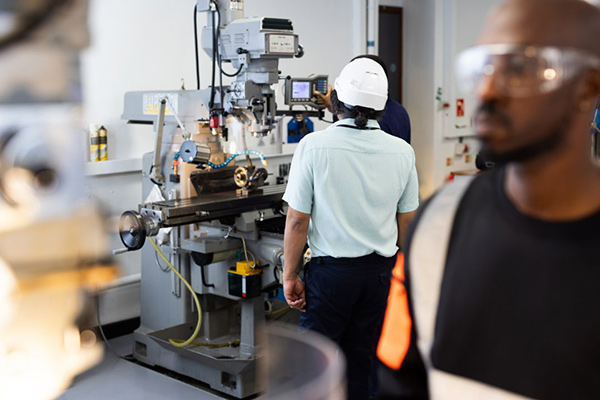Burnout is high, trust is low—but AI can help. New research from UKG shows how manufacturers can use it to support, not replace, their teams.

By Emory Lane, Senior Manufacturing Industry Principal, UKG
Burnout among frontline manufacturing employees has become a persistent and costly challenge. With nearly 80% of the global workforce made up of frontline workers — those who must be physically present to build, operate, or serve — the stakes are high. According to a new global study by UKG, burnout remains alarmingly widespread, with 76% of frontline employees reporting symptoms. Yet, the research reveals a surprising and hopeful insight: frontline workers who use artificial intelligence (AI) in their roles are significantly less likely to feel burned out.
This finding is especially relevant for manufacturers, where operational efficiency and workforce resilience are critical. The study, which surveyed 8,200 frontline employees across 10 countries, shows that those using AI report burnout rates 13 percentage points lower than their non-AI-using peers. However, the path forward isn’t without complexity. Many workers fear AI will replace their jobs or that colleagues skilled in AI may outpace them.
As manufacturers explore digital transformation, this article will unpack the challenges of burnout, offer practical strategies for using AI to support frontline teams, and share tips for introducing AI in ways that build trust, reduce stress, and unlock human potential — not replace it.
Burnout is often a chronic issue in manufacturing, where frontline employees face physical demands, rigid schedules, and mounting pressure to meet production goals. According to UKG’s global study, the number of employees feeling burned out has not improved over the last year – but there’s a new layer of complexity.
As AI becomes more integrated into manufacturing workflows, many frontline employees are experiencing anxiety about job security. Nearly two-thirds (64%) worry that AI might replace their job, and 65% fear a colleague skilled in AI could take their role. More than a quarter say part of their job has already been replaced by AI, and 1 in 5 believe their entire role could be gone within five years.
In today’s tight labor market, manufacturers must prioritize the wellbeing and retention of their existing workforce. That means addressing burnout not only through operational support but also by building trust around AI adoption. Transparent communication, ethical implementation, and people-first technology strategies are essential to keeping frontline teams engaged, empowered, and committed.
Manufacturers looking to reduce burnout among frontline employees should consider how AI can be used not to replace workers, but to support and empower them. The UKG global study found that frontline workers who use AI report significantly lower burnout rates (41%) compared to those who don’t (54%). This suggests that when AI is deployed thoughtfully, it can help shift work from menial to meaningful — freeing up time, reducing stress, and improving job satisfaction.
One of the most impactful applications of AI in the workplace is intelligent scheduling. AI can recommend best-fit schedules aligned with employee preferences and availability, helping reduce stress and improve work-life balance. It can also approve shift swaps and time-off requests in real time, giving employees the kind of on-demand responsiveness they’ve come to expect in their personal lives. Overall, the survey found 80% of employees would welcome AI-generated work schedules aligned with their preferences and availability.
AI can also support career development and HR processes. Three in four frontline workers say they would trust AI to recommend training, update certifications, and even help them explore new roles within the organization. These tools not only reduce administrative burden but also signal investment in the employee’s future — a key factor in retention.
For managers, AI can eliminate hours of administrative work, freeing them to spend more time on the production floor engaging with their teams. It can flag patterns in overtime and identify staffing gaps before burnout sets in. For example, if a machine consistently lacks coverage, AI can recommend who to train — preventing overwork and ensuring operational continuity.
By deploying AI with a people-first mindset, manufacturers can create a more supportive, efficient, and resilient workplace — one where both employees and operations thrive.
Successfully rolling out AI-guided solutions in manufacturing requires more than just deploying new tools — it demands thoughtful change management and a people-first mindset. The UKG study shows that frontline employees are eager to embrace AI when it’s used to eliminate tedious tasks and help them focus on meaningful work. In fact, 78% are comfortable using AI for HR processes, and 76% for workplace tasks. But transparency is key. Manufacturers must clearly communicate what AI is being used for, why it’s being introduced, and how it will support — not replace — the workforce.
Equally important is updating outdated processes. AI can streamline operations, but it needs human oversight. Take time-off requests, for example: instead of requiring managers to review every submission, AI can automatically approve requests that meet policy criteria and flag only those that need attention. This preserves managerial control while reducing administrative burden. Similar logic can be applied to shift swaps, training recommendations, and even performance evaluations.
A third best practice is investing in training and trust. With 65% of frontline workers fearing that colleagues skilled in AI could take their job, manufacturers must offer upskilling opportunities and involve employees in the rollout process. When workers understand how AI works and how it benefits them, adoption improves — and so does morale.
Ultimately, manufacturers should try to avoid positioning AI as a colleague or teammate: it has the biggest impact when it is used a tool. When introduced with clarity, empathy, and purpose, it becomes a catalyst for productivity, retention, and resilience.
Manufacturing leaders stand at a crossroad. The pressures of burnout, labor shortages, and operational complexity are real — but so is the opportunity. As the UKG study reveals, frontline employees who use AI the most are burned out the least. The key isn’t just adopting AI, but doing so with intention and empathy.
Organizations that roll out AI with transparency, updated processes, and a commitment to employee growth will not only reduce burnout — they’ll build trust, loyalty, and resilience. In a competitive labor market, that’s a strategic advantage. Manufacturers who embrace AI as a tool to elevate their people, not replace them, will outperform those who don’t.
The future of manufacturing isn’t just automated — it’s human-centered. And that’s where the real transformation begins.

About the Author:
Emory Lane is the Senior Industry Principal for Manufacturing at UKG, where he helps global manufacturers harness the power of AI, workforce intelligence, and operational excellence to drive transformation. With over three decades of executive leadership at Mohawk Industries, Emory has led enterprise-wide lean initiatives, MES implementations, and digital transformation strategies across complex manufacturing environments. A recognized champion of continuous improvement and data-driven decision-making, Emory brings a unique blend of engineering expertise and people-first leadership to the evolving future of work.
In this episode, I sat down with Beejan Giga, Director | Partner and Caleb Emerson, Senior Results Manager at Carpedia International. We discussed the insights behind their recent Industry Today article, “Thinking Three Moves Ahead” and together we explored how manufacturers can plan more strategically, align with their suppliers, and build the operational discipline needed to support intentional, sustainable growth. It was a conversation packed with practical perspectives on navigating a fast-changing industry landscape.